 | E-mail to Birds Korea |
 | KWBS |
in the Region
 | The Oriental Bird Club |
 | BirdLife International (Asia) |
March
March often contains a mixture of dry, cold days (with night temperatures down to 3-4°C, and highs between 10 and 15°C) and occasional milder showery, windy weather.
Most wintering species are still present, but in progressively reduced numbers. Falcated Duck regularly display on reservoirs and ponds, while small numbers of Baikal Teal remain at key sites. Migrant cranes peak in the northwest, as does the Ancient Murrelet migration along the east coast. Small numbers of shorebirds, including early Great Knot arrive, plus Siberian Buff-bellied Pipits and the first leucopsis White Wagtails. Hundreds of Rustic Buntings, Dusky and Naumann's Thrushes move north-east out of China and Japan, along with smaller numbers of raptors and occasional influxes of Japanese Waxwing. Bramblings and Siskins often form large flocks at key migration points. Sunny days tempt Rustic, Meadow, and Yellow-throated Buntings into song.
>March highlights are usually found by carefully searching through gull flocks for taxa like Pallas's Gull, barabensis, cachinanns, or smithsonianus, though Korea's first Japanese Accentor was found in March 2001 in Busan, Korea's first Bar-headed Goose on the Han-Imjin in 2003, and early migrant Red-billed Starlings and a Chinese Blackbird in 2004, and in 2006 Korea's eighth Pallas's (Great Black-headed) Gull - a species that seems to be a regular (though very scarce) winter visitor.
(The following records are a compilation of our own sightings and records sent in by other observers. As well as being posted on the Birds Korea website(s), selected records are also forwarded to other Korean-language birding websites; records of threatened species are arranged and forwarded to Birdlife International and national authorities when appropriate; flag images and records are passed to bodies responsible for their coordination throughout the flyway; and all records sent to us are used to compile annual reports and to support the evolving understanding of the status of many of Korea’s birds.)
Weiyeon Island-Geum Estuary, March 31
Following a tremendous thunderstorm in the morning, the Eocheong boat was cancelled, and Weiyeon was the best remaining option...in heavy overcast and murk (due to severe "yellow dust" conditions) first surprise of the day (on 31st) was a Curlew Sandpiper flying low over the sea, followed an hour later by a Grey-backed Thrush watched actually sitting ON the sea. Much to our amazement, the exhausted thrush flew up, followed and then landed on the boat - where it rested for the last 30 minutes of the trip, before finally heading for forest cover behind the harbor! The boat was also apparently used by a hitchhiking Dusky Thrush...
On the island itself, best for the day were 5-6 Red-billed Starling, 1-2 Dark-throated Thrush and 4 very late Siberian Accentor, with commonest migrants including Brambling (450), Yellow-throated (200) and Rustic Buntings (60), and Siberian Stonechat (40).
Of further note were the personal first ocularis White Wagtail (2) and Red-throated Pipit (2) of the spring, and excellent views by all three observers of a singing White's Thrush, making both higher and lower notes (clearly, the "duetting" of this species can be, (maybe always is?), given by just one bird).
Gangwha, March 31st
Most notable on the southern mudflat today were 3 Black-faced Spoonbills and c. 40 Wigeon on the bunori reservoir (somewhat scarce anywhere near Seoul). On the "bittern pond", 5 breeding-plumaged Garganey.
Also several Siberian Stonechats and leucopsis White Wagtails now apparent,and also 2 Bohemian Waxwing at Gimpo.
Talking of spring migrants, I noticed the first Barn Swallow, Little Ringed Plovers, Grey Wagtail and Hoopoe at Songdo on March 25th.
News of leg-flagged shorebirds
Today at the Geum (March 29), the same colour-banded female Bar-tailed Godwit that was found on Tuesday (L Up white flag, Low yellow/red bands, R Low yellow/white bands)was seen again, but the more exciting news is that a volunteer who joined me today, Lucas Snyder, on his first time out, found a second individually-marked Barwit on the same tidal flat!! Details as follows...
March 29th, Geum Barrage north side, spotted by Lucas Snyder
Female Bar-tailed Godwit
Left leg Upper - white flag, Lower - red over blue bands.
Right leg Lower - yellow over white bands.
The individual was seen on a low-tide among 173 other Bar-tailed Godwits spread loosely over the tidal area.
News of leg-flagged shorebirds:
March 27th, Shellfish Harbour
Great Knot (sex unknown), Upper right leg yellow flag. Bird was well into breeding plumage with dark markings on head and neck, and streaking across breast. Scapulars already turned rufous. Feeding in a small flock of 137 other Great Knots at close range.
March 27, Geum Barrage north side
News of leg-flagged shorebirds:
Bar-tailed Godwit:
Upper Right leg - white flag. Lower Right leg - yellow top and red under.
Lower Left leg - yellow top and white under.
Found amongst 338 other Bar-tailed Godwits on a rising tide.
March 26, Geum Barrage north side
Three leg-flagged Bar-tailed Godwit: all three birds seen feeding on a rising tide with 137 other Bar-tailed Godwits.
Female Bar-tailed Godwit, Upper Right leg black flag with orange lettering 'E0' (at first I thought I saw 'F0', but I believe there was a faint line to make the 'E') Flag had square corners, if that is at all useful.
Female Bar-tailed Godwit, Upper Right leg yellow flag with rounded edges.
Female Bar-tailed Godwit, Upper Right leg white flag with rounded edges. Upper left leg white band.
Dr Phil Battley (co-manager of the SSMP) comments:
" 2YWYR is a female and is the oldest bird we have banded. She was caught in April 1992 though not aged at the time, and recaptured and colourbanded in March 2004. She is currently 15+ in age, and potentially the oldest godwit doing the rounds. She was seen in Alaska last autumn on the staging grounds.
But what is even more impressive is E0. This is a satellite-tagged bird from 2005, when she was caught on the nest on the Yukon Delta. She was subsequently seen in the Manukau Harbour, New Zealand, the next non-breeding season, back in Alaska last summer, back in NZ this past season, and now you have her in Korea! Tony Habraken, who has seen her in NZ, also commented about her orangey lettering (it used to be white)."
Dr. Bob Gill (Alaska, Fish and Wildlife) and Dr. Phil Battley (Massey University, New Zeland, and one of the co-managers of the Saemangeum Shorebird Monitoring Program:SSMP), have mailed this morning (March 27) to say that two Bar-tailed Godwits carrying satellite transmitters put on in New Zeland in February, have today arrived in South Korea.
E1 (black flag, engraved white) is a large female and this morning's signal places her somewhere close to Asan Bay (the signal of this bird is not so accurate). The image of E1 reproduced below was taken in mid-February at Miranda, New Zealand, by Mr. Keith Woodley, SSMP participant (2006 and 2007) and Manager of the Miranda Naturalist's Trust shorebird centre.
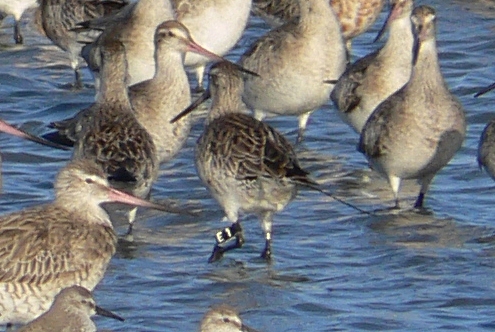
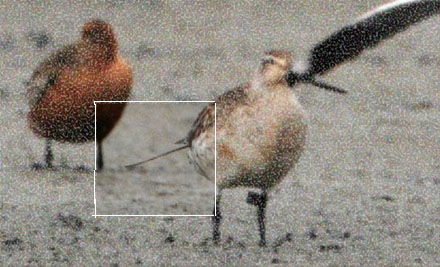
Original photo © Jan van de Kam)
She was at Miranda, near Auckland, this February and March, where she was photographed by Mr. Keith Woodley and by Mr. Jan van de Kam in mid-March - both SSMP participants in 2006.
Z0 (black flag, engraved white), is another female, and her signal suggests she arrived on the southern side of Jangbong Island, between Yeongjong and Ganghwa, this morning.
Both arrived in Korea after an amazing non-stop flight from New Zealand! The remarkable flight line taken by E1, from New Zealand to Asan, is illustrated below

Inner and Outer Geum, March 5-26
In an effort to supplement this year's SSMP with more data, daily counts at and around the Geum have proven to be very interesting. The main focus for these counts is to assess importance and use of areas which have been the focus of a possible reclamation project, to gather data on birds' arrival dates, peak dates, departures and colour banding/flagging, and to study the population distribution and movement between the 6 counting sites.
The sites included are the south side of the Geum River, the Geum Barrage, the lower Geum, 'Shellfish Harbour', Wolpo Harbour and the two Janggu bays.
High counts so far for the species already here have been 705 Great Knot (today - also the first day I've recorded them), 217 Bar-tailed Godwit (today), 621 'Eastern' Oystercatcher (today), 31 Kentish Plover (today), 5 Little Ringed Plover (March 23rd - first day), 6,578 Dunlin (March 18th), 438 Far Eastern Curlew (March 17th), 1,587 Eurasian Curlew (March 15th), 52 Spotted Redshank (March 12th) and 80 Northern Lapwing (March 20th). Saunders' Gull, Common Greenshank, Common Sandpiper and Grey Plover have also been recorded thus far.
Many thanks thus far to Jake MacLennan, Kim Hae-sun, Rachel Husband and Emily Styles for joining me on those cold and windy mornings! With new arrivals both of the past two counting days, and new highs for three other species today, the next week leading up to SSMP should be entertaining. Today was also the highest total count thus far - 8,187 birds, so the Spring migration is on!
Ui Island
This Bonelli's Eagle, found dead by local people, was photographed on March 21, 2007, on Ui Island, Shinnan-Gun, in the far southwest (about 50 Km west of Mokpo City). It has been tentatively aged as a 3 Calendar-year female, and was considered to have been dead only a short time.
Considering the location and the near-lack of a wild bird trade in South Korea, the species is considered to have been wild and Korea's first record: it has now been added to Category One of the Birds Korea checklist.
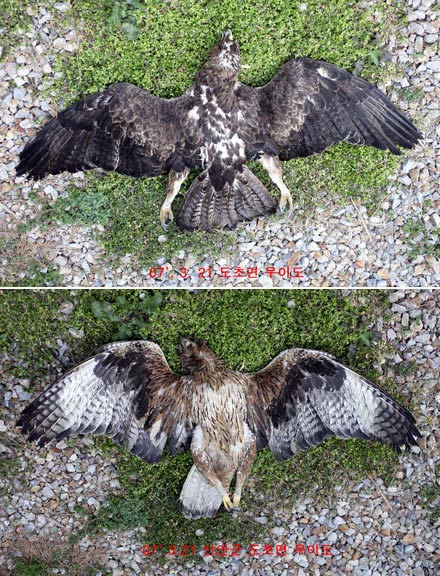
Saemangeum and the Geum Estuary, March 17 and 18
Some preliminary habitat assessment of Saemangeum and the Geum before the SSMP starts formally on April 01.
At Saemangeum, the sea-gates have been/were closed for a month (apparently following the drowning of some fisherfolk by an unexpected tidal surge in February), and the habitat is clearly significantly degraded. While full counts were not attempted, most numerous were Dunlin (several hundred), Far Eastern Curlew (ca 100), and Spotted Redshank (ca 110), with most unexpected 2 Black-winged Stilt.
At the Geum, the main mainland sites held 438 Far Eastern and 799 Eurasian Curlews, 2,112 Dunlin and 522 Eastern Oystercatcher on 17th, while at Yubu Island on 18th most numerous were Eurasian Curlew (2, 635), Grey Plover (1,800), Far Eastern Curlew (1,201), Dunlin (1,300), and Eastern Oystercatcher (633).
Further highlights there included an orange-flagged Far Eastern Curlew (upper left leg, with the vividness of the orange suggesting a recent placement), single Mongolian Plover and Ruddy Turnstone, and 6 Bar-tailed Godwit. As further evidence that the Bar-taileds had most likely arrived on the 18th, a further single was also seen at the Geum barrage - a first for this site this year, despite being counted near-daily since March 1 by GS.
Junam, March 18
This weekend a Red-flanked Bluetail was present at Junam reservoir forest edges. However it was chased away by a female Daurian Redstart defending her territory.
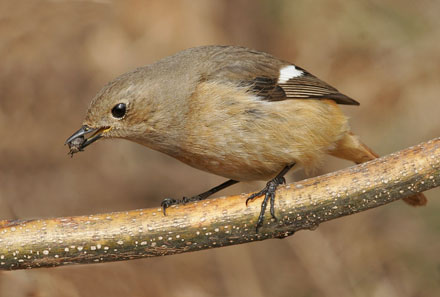
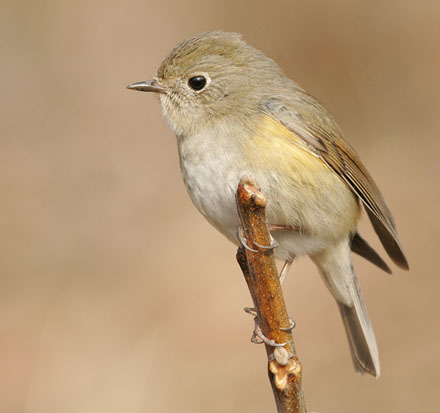
Seosan Lake A and Han-Imjin, March 12
In calm and sunny conditions, several hours searching unsuccessfully for the Oriental White Storks at Seosan A - with their preferred area this morning suffering from extensive construction work. Despite this, some excellent birds and birding, starting with a singing Chinese Grey Shrike, and including a flyover Lesser White-fronted Goose (heard only, in among several thousand Greaters), 94 Hooded Crane with one Common Crane, an Upland Buzzard, an albidus Northern Goshawk and what appeared to be last month's putative Steppe Buzzard again (too far for disgiscoping, with the tail also hidden from view), as well as excellent views of both Common and Pallas's Reed Buntings and singing Chinese Penduline Tit. Even better (for MK at least) were excellent though brief views of an Amur Leopard Cat, running along the track in front of us.
At the Han-Imjin, 390+ Swan Goose, 270+ White-naped Crane, 1500+ Mongolian Gull, and brief views of a Siberian Accentor, while NM also saw 30+ Cinereous Vulture on Yeongjeong island from the road back to Seoul.
Arboretum - Song Do - Seosan Lake A and Lake B, March 11
Another long day, with lots of driving and some excellent birds. Near the arboretum, still 2 Solitary Snipe, probably half-a-dozen Pallas's Rosefinch, and a calling (unseen) highly unseasonal Tristram's Bunting, along with at least 4 species of woodpecker heard. Biggest surprise of all (literally) was presumably yesterday's Korean Water Deer, chased by a feral dog, hurtling past within 1 metre of us...
At Song Do, no Relict Gull, but at least 317 Saunders's Gull (most in full breeding plumage), ca 1000 Eurasian and 25 Far Eastern Curlews, 2600 Dunlin, 70 Kentish Plover and least expected, a first winter Pallas's Gull - identified at long range by e.g. the combination of size, long, drooping bill, long-necked look, grey nape, slight eye-patch, and pale wing covert bar at rest.
At Seosan, no sign of the 3 Oriental White Stork seen earlier in the day by Mr. Kim Hyun-tae, instead 4, 500 Baikal Teal, 8 Far Eastern Curlew, and several leucopsis White Wagtail. A long slow drive back to Seosan in the dark added Short-eared Owl, 3 Raccoon Dog and close views of another, much more relaxed Korean Water Deer.
Guryongpo - NE River - Arboretum, March 10
The longest driving day (in many years of birding in Korea!), in conditions ranging from cold, calm sunshine, to heavy snow and then fair skies. At Guryongpo, good views of single Long-billed Murrelet and Rhinoceros Auklet (the former still in non-breeding and the latter in near breeding plumage), as well as several (uncontroversial!) Pacific Loons.
At the NE River, again massive disturbance, but still 2 Scaly-Sided Merganser (including the male with the very slightly deformed bill, photographed at the same site on January 30, 2005: see news archives) and also 2 White-tailed Eagle in addition to a pair of Mandarin Duck.
At the arboretum, in rapidly failing light, very poor views of one Solitary Snipe, and rather better views (by NM) of a Korean Water Deer.
Eungbong(Seoul), March 12
A return to Eungbong to again admire the rare ducks found the Red-crested Pochard in fine form, watched and photographed by a number of entranced local (and not-too-local) birders, all of whom were acting with care and respect toward the rare visitor.
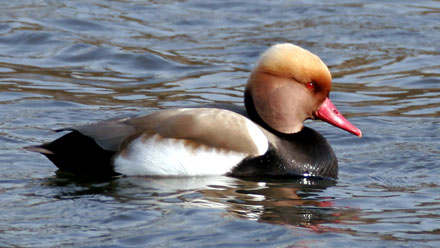
With light starting to fade, I went downstream to find the slightly puzzling Ferruginous Duck, which shows some (intermittently peaked and flattish head, greenish iridescence) characteristics that might recall a Baer's Pochard ...
Gunsan vicinity, March 11
In a tidal canal a Green Sandpiper as well as a Common Sandpiper were seen. The tidal flats in the morning had a couple of osculans Oystercatchers as well as a few Swan Geese and a scattering of Northern Lapwings; another group of two dozen were seen later by the city reservoir. PN noted a few Saunders' Gulls. In the reeds a few Common Reed Buntings were observed (JM).
The first Barn Swallows of the year for either observer were seen along the Keum. Up river thousands of Baikal Teals remain.
The reservoir near Seong-san Village had scores of Northern Shovelers. Eleven male Falcated Ducks were counted. A Water Rail seen on the 10th (JM) was looked for, but only three Moorhens could be seen in the small reservoir in Seokae-jang Village. The Ok-gu Reservoir was inspected: the Horned Grebe, Artic Diver and a single Whiskered Tern remain.
The city reservoir had about 10 Greater Scaup and a small group of Dusky Thrushes (all seen well were naumanni).
Oksu, March 11
A thorough count of waterfowl extending from Oksu (Han river) to Eunbong (jungnangcheon stream) revealed the following : 3100 Tufted Duck, 2510 Common Pochard, 210 Common Teal, 180 Pintail, 160 Shoveler, 104 Gadwall, 56 Mallard, 40 Spot-billed Duck, 11 Wigeon, 2 Smew, 1 Goosander, 1 Greater Scaup, & 1 Mandarin. Numbers are similar to previous years, although now there are notably more Gadwall and Eurasian Wigeon.
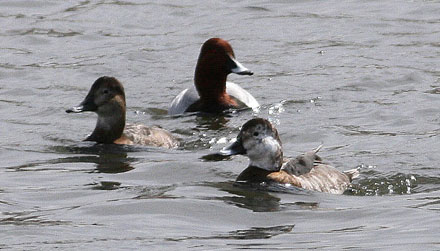
Of especial note was the Ferruginous Duck (drawing crowds of photographers) and the Red-crested Pochard still (seen in the morning by Rich lindie).Also present was the Ferruginous Duck X Common Pochard hybrid, and an albinistic female Common Pochard.
The entire riverside walk of c. 2km is now signposted as a "Migratory bird protection area", which is encouraging, although it would be much improved by restoration of some waterside vegetation.
Eungbong (Seoul), March 11
A trip to see the Ferruginous Duck that eluded us last week was shortened following the arrival of some photographers.
The bird showed well but was frequently disturbed along with the other birds in the area. I have always enjoyed 'twitching' rarities and vagrants in the past - News is normally spread eagerly among twitchers, posted immediately on forums etc. but it is clear why this is not the case in Korea. Two eager photographers asked me to show them 'the rare bird with a red chest' and clearly had no real interest in birds or how to behave around them, only flushing the bird in the process.
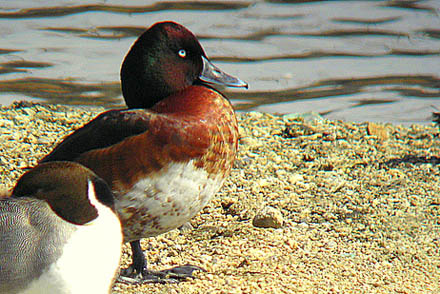
and the scalloped breast of this bird perhaps better indicate a hybrid between
Ferruginous Duck and Baer's Pochard Aythya baeri, © Rich Lindie
Eungbong (Seoul), March 5 and 7
An evening trip to Eungbong in search of the Red-crested Pochard and Pallas' Gull reported by Richard Lindie and Hayley Wood and the Ferruginous Duck reported by Mr. Kim Dong-won (on the 3rd and 4th of March, respectively) was successful for both ducks.
A return trip on the 7th by R.N. found neither duck but the Pallas' Gull was well in evidence, as were increasing numbers (over 1000) of Tufted Ducks, and 38 Smew out on the Han - a personal high count for this site.
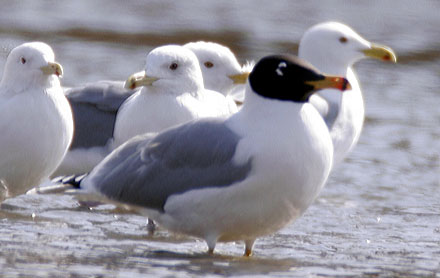
Photo © Robin Newlin
Eungbong (Seoul), March 3
A short trip to the stretch of river between Eungbong and Oksu stations yielded two good rarities within the first 5 minutes. Great scope views of a Pallas's (Great Black-headed) Gull and a Red-crested Pochard on the same sandbank.
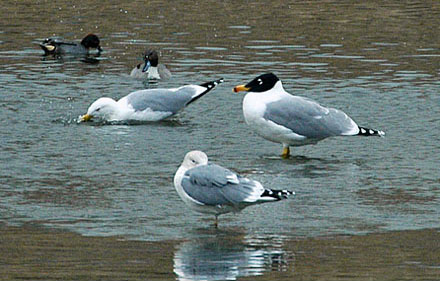
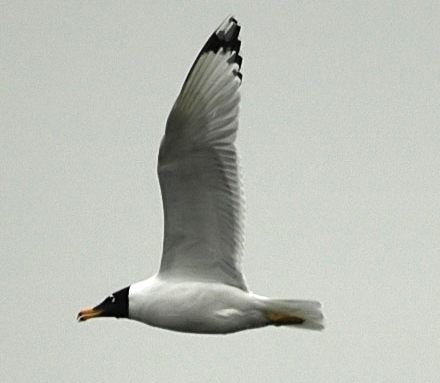

Photos © Rich Lindie
Seosan, March 3
Warm, wet and overcast weather, and birds on the move is signalling the transition from winter to spring: numbers of Hooded Cranes have built up to 45 individuals now, as well as outstanding new arrivals 2 Common Cranes, accompanied by 2 young Common X Hooded Crane hybrids, the latter showing the overall ash grey, dark-tipped plumes of Common, as well as the patchy white necks and dark primaries of Hooded.
Winter favourites 5 Oriental White Storks remain, as well as 27 Eurasian Spoonbills, 39 Whooper Swans, 2 Smew, c.15 Chinese Penduline Tits, a single Baikal Teal, 2 "Eastern" Oystercatcher & several Goldeneyes and Tufted Ducks.
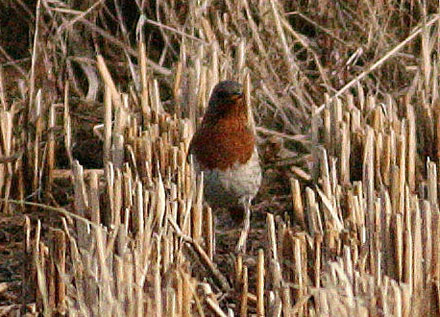
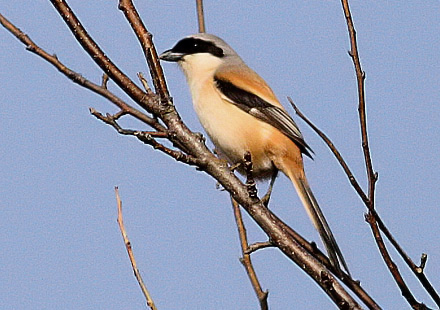
Near to the ever-present Long-tailed Shrike, numbers of Dusky and Naumann's Thrushes have built, this time including a superb (Dark-) Red-throated Thrush, which froze when one of 2 Upland Buzzards soared overhead. Good views were had of a grounded Northern Goshawk, which was momentarily surprised by a spectacular adult male Hen Harrier.
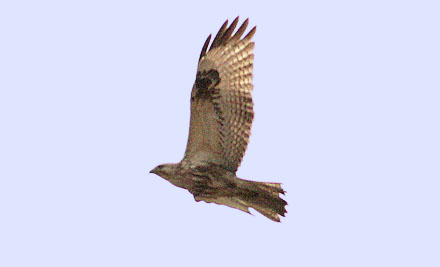
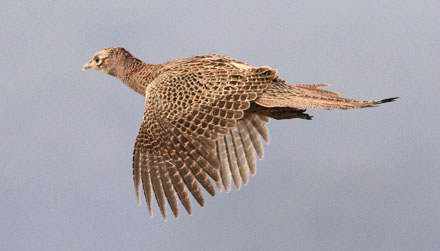
Signs of spring included large accumulations of Black-headed Gulls and Common Shelducks, and 8 Northern Lapwings, with one individual sporting a really outsized crest. Also of note were 4 Eastern/ Japanese Quail, 2 Common Moorhens, and a Common Kingfisher which appears to have overwintered.
Seosan Lakes A and B, March 1
A cool morning turning into a warm and sunny afternoon produced a mix of end-of-winter and start-of-spring feelings. 3 Oriental White Storks were seen, along with 36 Hooded Crane. The biggest surprise of the morning was a Spotted Redshank, who was tagging along with 31 Northern Lapwing, and is an unusual sighting for this time of year. That with the lack of Swans (only 2 seen) and Spoonbills (only 4) got us thinking about spring.
On the lake, c. 40 Dunlin flew in a tight flock while 2 Kestrel were busy building their nest on the side of the factory's silo, and, from what we can guess, were seen mating on an adjacent ladder. The Chinese Great Grey Shrike was seen again, this time further south than the last time. 2 Brambling represented the winter perching birds. 2 Common Kingfishers were in their usual spots up the north end of Lake A.
On Lake B, the Long-tailed Shrike gave excellent views, and was thinking seriously about leaping into a large group of Tree Sparrows. Long-tailed Tits and Rustic Buntings also chirped nearby. Thrushes were everywhere in that area, with rough counts of c. 18 Dusky Thrush eunomus and c. 24 naumanni plying the fields and adorning the power lines. 55 species in all with some great close-up looks at some good birds.
Namhansan - Han River - NE River - Arboretum, March 1
In very warm sunshine (with temperatures warming rapidly from 2C at dawn to 18C in the afternoon), a very busy day, with lots of excellent birds! At Namhansan, best were a male White-backed Woodpecker feeding close to the road and 4 Pallas's Rosefinch (very scarce this winter), while other typical species there included Varied Tit and abundant Eurasian Nuthatch. At The Han, one adult Steller's Sea Eagle still, along with Little Bunting, and a flock of ca 400 Greater White-fronted Geese, carrying at least 2 Lesser White-fronteds with them.
From there, a long drive to the NE river, where the increasingly disturbed site still held one male and one female Scaly-sided Merganser, and one pair of Brown Dipper apparently in territory. A further long drive finally brought us to the arboretum, where one Solitary Snipe was watched well as range, feeding almost unnoticed along the river-edge.





